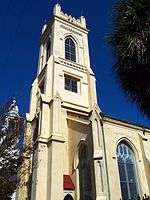Unitarian Church in Charleston
|
Unitarian Church in Charleston | |
|
Unitarian Church of Charleston | |
  | |
| Location | 4 Archdale St., Charleston, South Carolina |
|---|---|
| Coordinates | 32°46′20″N 79°56′2″W / 32.77222°N 79.93389°WCoordinates: 32°46′20″N 79°56′2″W / 32.77222°N 79.93389°W |
| Built | 1854 |
| Architect | Francis D. Lee |
| Architectural style | Gothic Revival |
| Part of | Charleston Historic District (#66000964) |
| NRHP Reference # | 73001696 |
| Significant dates | |
| Added to NRHP | November 7, 1973[1] |
| Designated NHL | November 7, 1973[2] |
| Designated NHLDCP | October 9, 1960 |
The Unitarian Church in Charleston, home to a Unitarian Universalist congregation, is an historic church located at 4 Archdale Street in Charleston, South Carolina. It is "the oldest Unitarian church in the South" and is a National Historic Landmark.[3] It is the second oldest church in downtown Charleston. Its construction began in 1772 when the Society of Dissenters (now known as the Circular Congregational Church) needed more space than its Meeting Street location could provide. It was nearly complete in 1776 when the Revolutionary War began, finally being repaired and officially dedicated in 1787.
It was declared a National Historic Landmark in 1973.[2][4]
History

The Unitarian Universalist Church was not originally built by the Unitarians. It was constructed by the Society of Dissenters who needed more worship space. Construction began in 1774 and was nearly complete in 1776 when the Revolutionary War ignited. It is thought that when the British occupied Charleston, they quartered militia and possibly even horses in the building.[5] It was not until after the war ended that the building could be repaired and officially dedicated in 1787. It was unofficially named The Archdale Street Meeting House.[6]
For 30 years following the dedication, the Meeting Street and Archdale Street churches operated as a single entity. They shared not only the same two ministers, but the same sermon was delivered each Sunday. Drs. Hollinshead and Keith, co-pastors of the church, preached one sermon in both houses each Sunday, alternating morning and afternoon services. In 1817, one of the ministers and several congregants became Unitarians, moved to the Archdale Street Meeting House, and founded the Second Independent Church in Charleston.
The group was rechartered as the Unitarian Church in 1839. Francis D. Lee, a Charleston architect and church member, was hired in 1852 to enlarge and remodel the building. Inspired by the Chapel of Henry VII at Westminster Abbey and St George's Chapel at Windsor Castle, Lee completed the project two years later. The fan-vaulted ceiling, nave, and chancel closely resembled their English prototypes; the stained glass windows were considered among the finest in the country. The church may have been the first Gothic architecture built in the United States. The style is referred to as English Perpendicular Gothic Revival.[7]

Just 32 years later, the great Charleston earthquake of 1886 struck, shearing off the entire top of the church's tower, including eight paneled buttresses, high pinnacles and medieval-style finials. Masonry from the tower fell through the fan-vaulted ceiling below. A Boston architect by the name of Thomas Silloway came to Charleston after the quake to repair the damage. With funds raised by Unitarian churches throughout the country, he restored the interior to Francis Lee's original design. The tower, however, was rebuilt in a slightly less elaborate form with the pinnacles and parapet lowered and simplified. This was solely to increase structural stability in the event another earthquake struck Charleston.
More than one hundred years passed before Charleston faced another natural disaster. Hurricane Hugo struck the Holy City in 1989, causing massive damage in the historic district. The roof of the Unitarian Church was lost during this devastating storm. Following Hugo, the church was repaired to the specifications set by Thomas Silloway and remains nearly unchanged to this day.

See also
- Unitarian Universalist Association
- List of National Historic Landmarks in South Carolina
- National Register of Historic Places listings in Charleston South, Carolina
References
- ↑ National Park Service (2007-01-23). "National Register Information System". National Register of Historic Places. National Park Service.
- 1 2 "Unitarian Church". National Historic Landmark summary listing. National Park Service. Retrieved 2008-02-16.
- ↑ National Park Service listing
- ↑ Tray Stephenson and Bernard Kearse (April 25, 1973), National Register of Historic Places Inventory-Nomination: Unitarian Church (pdf), National Park Service and Accompanying one photo, exterior, from 1973 (32 KB)
- ↑ http://www.charlestonuu.org/index.php?page=HistoryPage
- ↑ Circular Congregational Church - History Archived June 8, 2007, at the Wayback Machine.
- ↑ http://www.charlestonuu.org/index.php?page=HistoryPage#toc6
External links
 Media related to Unitarian Church of Charleston at Wikimedia Commons
Media related to Unitarian Church of Charleston at Wikimedia Commons- Official website
- Circular Congregational Church of Charleston
- Unitarian Church, Charleston County (6 Archdale St., Charleston), including 10 photos, at South Carolina Department of Archives and History
- Historic American Buildings Survey (HABS) No. SC-473, "Unitarian Church, 6 Archdale Street, Charleston, Charleston County, SC", 17 photos, 3 photo caption pages, supplemental material
.jpg)

